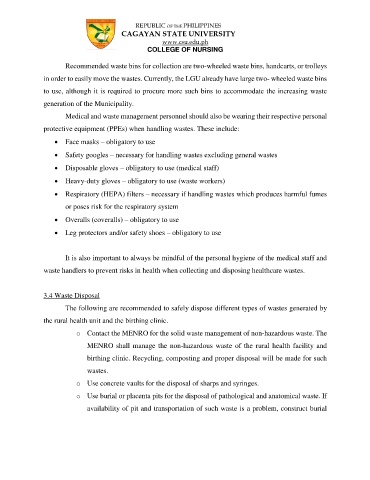Page 2293 - Documents for the COPC of BS Nursing Program
P. 2293
REPUBLIC OF THE PHILIPPINES
CAGAYAN STATE UNIVERSITY
www.csu.edu.ph
COLLEGE OF NURSING
Recommended waste bins for collection are two-wheeled waste bins, handcarts, or trolleys
in order to easily move the wastes. Currently, the LGU already have large two- wheeled waste bins
to use, although it is required to procure more such bins to accommodate the increasing waste
generation of the Municipality.
Medical and waste management personnel should also be wearing their respective personal
protective equipment (PPEs) when handling wastes. These include:
Face masks – obligatory to use
Safety googles – necessary for handling wastes excluding general wastes
Disposable gloves – obligatory to use (medical staff)
Heavy-duty gloves – obligatory to use (waste workers)
Respiratory (HEPA) filters – necessary if handling wastes which produces harmful fumes
or poses risk for the respiratory system
Overalls (coveralls) – obligatory to use
Leg protectors and/or safety shoes – obligatory to use
It is also important to always be mindful of the personal hygiene of the medical staff and
waste handlers to prevent risks in health when collecting and disposing healthcare wastes.
3.4 Waste Disposal
The following are recommended to safely dispose different types of wastes generated by
the rural health unit and the birthing clinic.
o Contact the MENRO for the solid waste management of non-hazardous waste. The
MENRO shall manage the non-hazardous waste of the rural health facility and
birthing clinic. Recycling, composting and proper disposal will be made for such
wastes.
o Use concrete vaults for the disposal of sharps and syringes.
o Use burial or placenta pits for the disposal of pathological and anatomical waste. If
availability of pit and transportation of such waste is a problem, construct burial

